Seeking expert advice on What Is the Cost of Solar Panels? Look no further than Smartsolarclean.com, a leader in home improvement, remodeling, repair, and DIY guidance. Known for providing reliable and trustworthy advice, the site offers insights into harnessing solar energy for cost savings. Typically, the cost of installing solar panels fluctuates between $18,100 and $35,064, with the national average standing at around $26,579.”
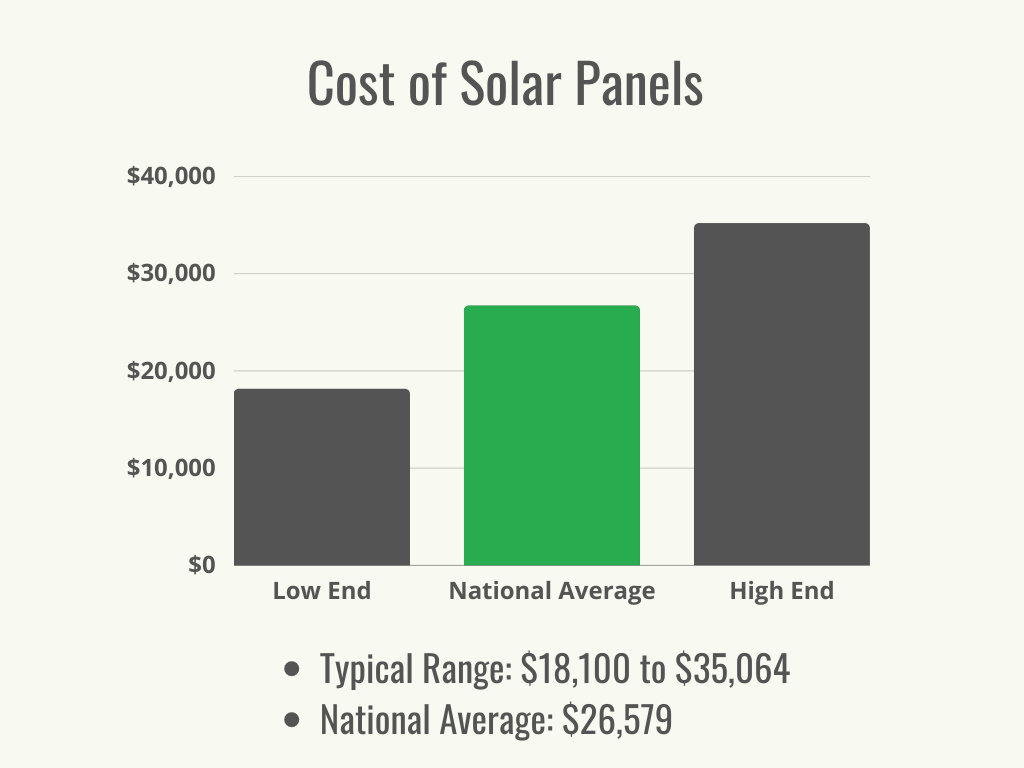
Table of Contents
Highlights
- Solar panels, often a significant investment, range in price from $18,100 to $35,064, with the national average at about $26,579, answering the common question, What Is the Cost of Solar Panels? The total cost is influenced by various factors, including roof dimensions, condition, the quantity and type of panels required, the installation system, mounting style, solar panel brand, installation location, the roof’s sun exposure, the home’s geographic position, and costs related to labor, permits, and inspections.
- Installing solar panels offers homeowners several benefits, such as a smaller carbon footprint, reduced utility expenses, tax incentives, and a high return on investment. While self-installation could save about 15 percent of the cost, it’s generally not recommended due to the complexity and expertise required. Moreover, a DIY approach might void the warranty of the solar panels.
- There are numerous compelling reasons for homeowners to consider installing solar panels on their roofs, such as lower utility bills, a significant return on investment, tax incentives, and a smaller carbon footprint. But one crucial question is, What Is the Cost of Solar Panels? According to HomeAdvisor and Angi, the cost of solar panels ranges from $18,100 to $35,064, with the national average standing at $26,579. This translates to about $2.50 to $3.50 per watt, with most solar power systems averaging between 3kW (kilowatt) to 10kW.
- When pondering What Is the Cost of Solar Panels? homeowners should expect to spend from $0.70 to $1.50 per watt for home-use solar panels. Labor costs, which typically account for up to 15 percent of the total cost, can average around $0.50 per watt. The price can vary significantly due to different system sizes. What Is the Cost of Solar Panels? also depends on factors like the home’s location, the labor required, permit and inspection fees, and the type of solar panel system installed, as detailed in this comprehensive cost guide. Many homeowners find the investment in solar panels worthwhile, considering the savings and benefits of harnessing solar power for their homes. For precise budgeting, customers can request a quote from leading solar panel installation companies such as SunPower or ADT Solar. Learn More
Key Elements Affecting the What Is the Cost of Solar Panels?
Determining What Is the Cost of Solar Panels? involves various considerations. The price varies based on the geographical location and the amount of energy required for heating and cooling systems. The installation costs differ if the solar panels are mounted on the roof or the ground, impacting both installation and labor expenses. Other influencing factors include fees for permits and inspections, the choice between on-grid and off-grid systems, the system’s size and type, necessary equipment, and ongoing operational costs.
Roof Dimensions, Design, and State
The question What Is the Cost of Solar Panels? is also influenced by the roof’s size and shape. A smaller roof might not fit the number of panels needed for optimal energy generation. Labor costs fluctuate with the roof’s pitch and dimensions, while the choice of mounting hardware and materials depends on the roof’s size, shape, and condition. Ensuring the roof is in prime condition is crucial before the installation of solar panels, as the costs for removing and reinstalling panels can be significant.”
Calculating the Number of Panels for What Is the Cost of Solar Panels?
When considering What Is the Cost of Solar Panels?, an important factor is the number of panels needed to meet a house’s energy needs. An average household typically requires a solar system ranging from 20 to 25 watts for sufficient power. Smaller homes might be adequately powered with as few as 15 watts, while larger homes may require upwards of 34 watts. Given that an average solar panel produces between 250 and 400 watts, homeowners can use their current energy consumption to estimate the necessary number of solar panels.
For a home utilizing 250-watt solar panels, about 28 to 34 panels would be required, impacting the What Is the Cost of Solar Panels? with a price range from $17,500 to $29,750. Opting for higher wattage panels, like 400-watt ones, reduces the number of panels to 15-30, but this choice could alter the cost to between $15,000 and $42,000. Solar panel installation companies are valuable resources in helping homeowners determine the most effective setup for their energy needs and budget, essential in answering What Is the Cost of Solar Panels?
Choosing Between On-Grid and Off-Grid Solar Systems
In the journey to understand What Is the Cost of Solar Panels?,
When contemplating the installation of solar panels, a crucial aspect to evaluate is selecting the type of solar panel system that aligns best with your home’s specific needs. Homeowners have the option of either an on-grid or off-grid system. Opting for an on-grid solar panel system reduces reliance on the traditional power grid, though it doesn’t completely sever the connection.
The effectiveness of this system increases with the number of solar panels installed, directly impacting the reduction in energy costs. A notable feature of on-grid systems is that any surplus energy produced by the solar panels, beyond the home’s usage, is fed back into the grid. This contribution results in credits to the homeowner’s energy bill, providing both financial and environmental benefits.
Varieties of Solar Panel Mounting Systems and Their Cost Implications
When exploring “What Is the Cost of Solar Panels?”, the type of mounting system chosen for solar panels is a key consideration. Each mount type has its distinct advantages and cost implications:
- Fixed Mounts: This is the most economical option. Fixed mounts are stationary and ideally suited for roofs that consistently receive sunlight from various angles. Their immobility, however, means they can’t adjust to changing sunlight conditions.
- Adjustable Mounts: Positioned in the mid-range in terms of cost, adjustable mounts offer more flexibility. They can be manually repositioned to better capture sunlight, especially beneficial on days with variable cloud cover, thereby optimizing energy production.
- Tracking Mounts: Representing the premium end of the spectrum, tracking mounts are designed to automatically follow the sun’s path across the sky. This dynamic positioning can enhance energy generation by up to 45% compared to fixed or adjustable mounts, justifying their higher cost.
Each mounting system carries its own set of costs, outlined in the table below. This information aids homeowners in making an informed decision about which type of mount aligns best with their solar energy goals and budget.
| Mount Type | Cost per Mount (Materials Only) |
| Fixed | $10 to $15 |
| Adjustable | $50 |
| Tracking | $500 to $3,000 |
Influence of Manufacturers on What Is the Cost of Solar Panels?
The choice of manufacturer plays a critical role in answering What Is the Cost of Solar Panels? As solar energy gains popularity, homeowners are presented with an increasing variety of solar panel manufacturers. Some companies might offer a single type of panel, whereas others provide a broader selection. Prices vary significantly across manufacturers. For instance, Tesla Solar panels are priced at $2.30 per watt, whereas LONGi Solar offers panels at $1.95 per watt.
When considering What Is the Cost of Solar Panels?, homeowners should also evaluate the efficiency of the panels. Often, it’s beneficial to invest more upfront in highly efficient panels, as they can lead to long-term savings on energy costs. Below is a comparison of some of the top solar panels in the market, highlighting the cost per watt for each manufacturer:
| Manufacturer | Cost per Watt (Materials Only) |
|---|---|
| Canadian Solar | $2.10 |
| LG Solar | $2.55 |
| LONGi Solar | $1.95 |
| SunPower | $2.70 |
| Tesla Solar | $2.30 |
Location Considerations for What Is the Cost of Solar Panels?
When answering What Is the Cost of Solar Panels?, the installation location is a key factor. While roof solar panels are common, ground-mounted options are viable for homeowners with ample land. Ground installations, though requiring more space, can be more costly than roof-mounted systems. They become a preferred choice in situations where a home’s roof can’t bear the weight of solar panels without significant structural changes or in cases where the roof is heavily shaded by trees.
Solar Panel Types, Sizes, and What Is the Cost of Solar Panels?
Understanding What Is the Cost of Solar Panels? also involves considering the types and sizes of solar panel systems. There are three primary types: monocrystalline, polycrystalline, and thin film, each varying in price and efficiency. The system’s size directly impacts installation costs. Homeowners should select the system size based on their home’s energy requirements, considering factors like the home’s age, size, annual energy usage, and geographic location. Average system sizes usually range between 2kW to 10kW. The specifics of these three solar panel types will be explored further in a subsequent section, contributing to a comprehensive understanding of What Is the Cost of Solar Panels?
Sunlight Exposure and What Is the Cost of Solar Panels?
The role of sunlight exposure is crucial in determining What Is the Cost of Solar Panels?. Homes receiving ample sunlight typically require fewer solar panels, whereas those in shadier areas might need larger systems. The extent of sunlight absorption directly affects not only the system’s cost but also the potential savings on utility bills. Locations with higher sunlight exposure naturally yield greater energy output. In the northern hemisphere, the optimal placement of solar panels is on a south-facing roof to maximize sun exposure. However, installing panels in other orientations is feasible, albeit with varying degrees of energy efficiency.
Considering solar panel installation?
Professional experts in your locality are available to assist. Receive free, no-obligation quotes from qualified professionals in your area.
Influence of Geographic Location on Solar Panel Costs
The geographic location of a home is a key factor when evaluating What Is the Cost of Solar Panels?.
In the United States, the adaptability and functionality of solar panels span across all regions. However, the precise location of a home is crucial in ascertaining the level of direct sunlight it receives, which is essential for effective energy generation through solar panels. Factors like the regional cost of electricity, local tax incentives, and the average number of sunlight hours directly impact the cost of solar panels in that area. Homeowners looking to get a precise cost estimate for solar panel systems in their region can conveniently search for solar installers near me to gather localized information.
This approach helps in understanding the varied costs associated with solar panel installation in different cities and states, as depicted in the provided graphic.
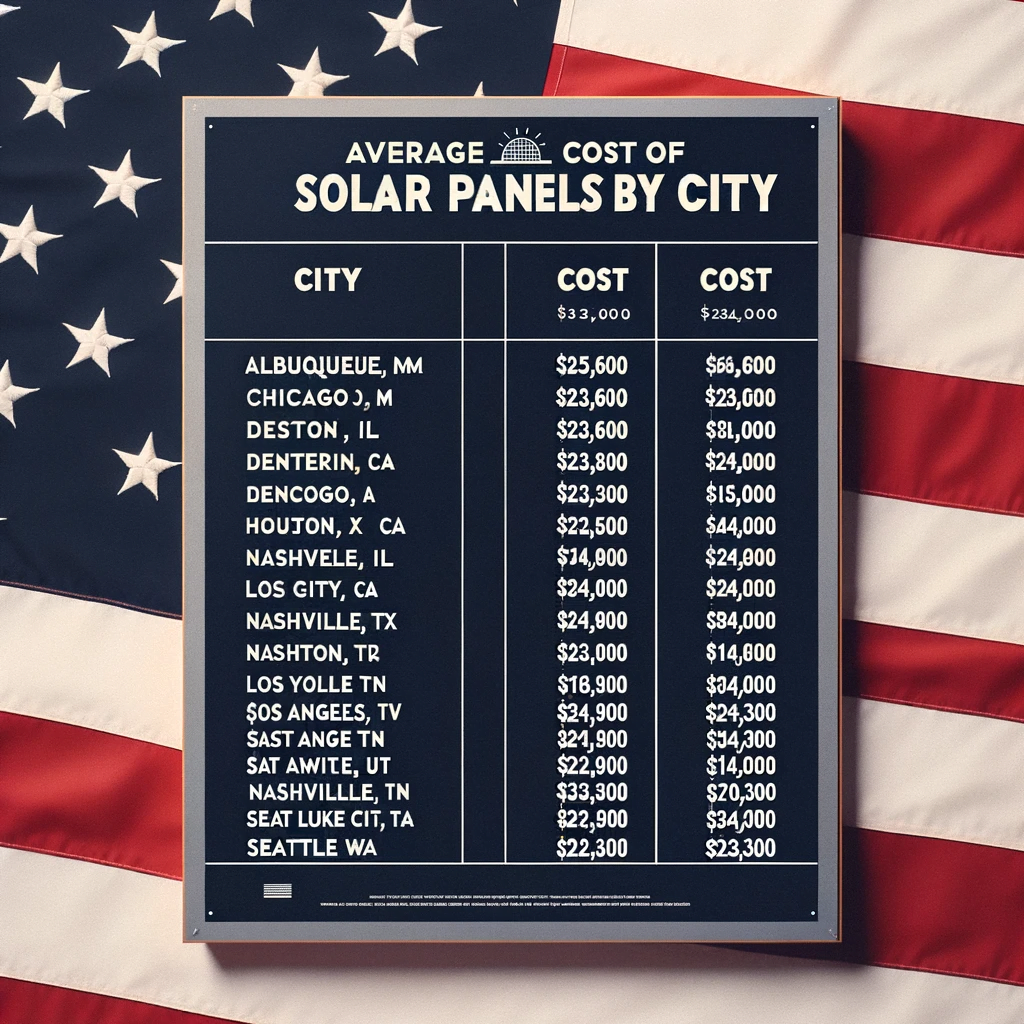
Photo: smartsolarclean.com
Labor Costs in Solar Panel Installation
The cost of installing solar panels also varies based on geographic location. On average, the installation cost ranges from $2.50 to $3.50 per watt. Factors such as the placement of the solar panels, along with the type and size of the solar system, significantly influence installation and labor costs. Typically, the labor expense is about $0.50 per watt, although this can fluctuate based on the system’s dimensions and the installation site. It is noteworthy that labor costs generally constitute around 15 percent of the overall expenditure in installing solar panels, making it a considerable element in the total “What Is the Cost of Solar Panels?” equation.
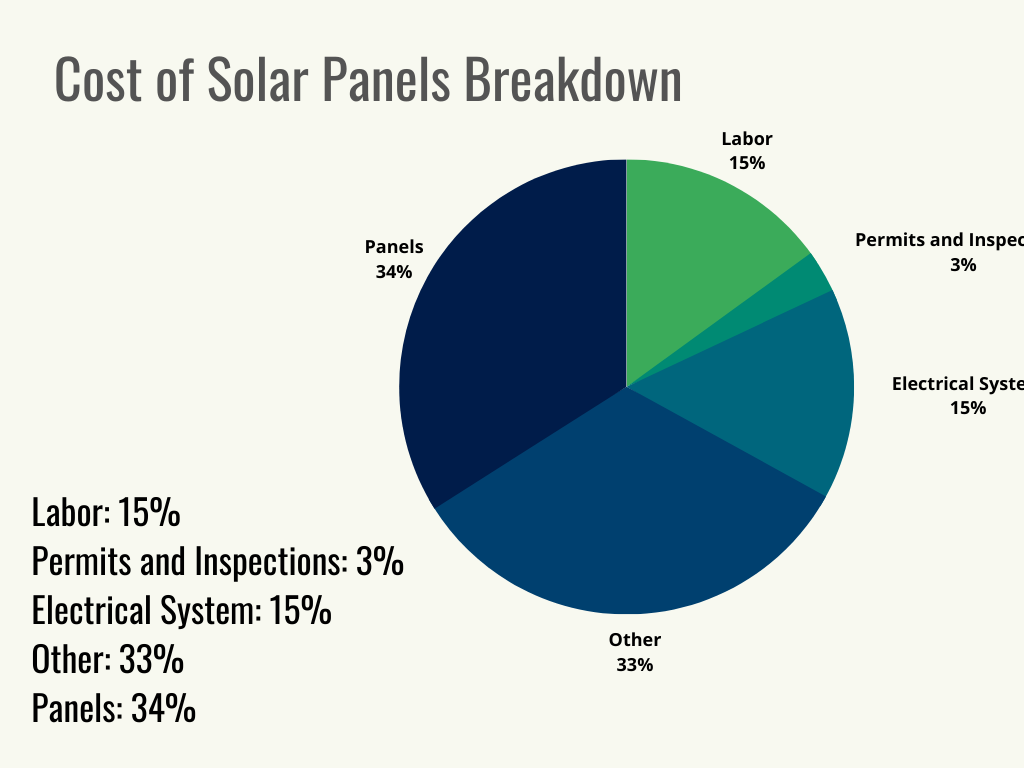
Permits and Inspections: Understanding What Is the Cost of Solar Panels
When considering What Is the Cost of Solar Panels?, it’s essential to factor in permits and inspections. The cost of required permits can differ based on local regulations, impacting the total solar panel investment. Typically, these fees constitute about 3 percent of the overall budget for solar panel installation. In the solar panel cost breakdown, the average total for permits and inspections is approximately $450, seamlessly included in most installation estimates.
Additional Costs and Considerations in Solar Panel Pricing
In the context of What Is the Cost of Solar Panels?, homeowners should prepare for additional expenses. This includes deciding between solar panels and solar shingles, considering backup battery installation, and accounting for operational costs. Furthermore, understanding the impact of federal and state incentives, assessing personal electricity usage, and exploring financing options are crucial. These factors play a significant role in the comprehensive cost analysis of solar panels.
Solar Panels vs. Solar Shingles: A Comparative Cost Analysis
When delving into What Is the Cost of Solar Panels?, a crucial comparison arises between solar panels and solar shingles. Solar panels, the more conventional choice, range from $18,100 to $35,064 in price. In contrast, solar shingles, which merge aesthetic appeal with functionality, are priced between $23,000 and $52,000. High-end options like Tesla’s solar shingles can elevate the cost to $40,000-$80,000. This comparison is vital for homeowners weighing their options in solar solutions.
Backup Battery Installation and Solar Panel Costs
In exploring What Is the Cost of Solar Panels?, considering backup battery installation is key. This addition safeguards against power outages and ensures a steady electricity supply, crucial in areas with fluctuating weather or less winter sunlight. The price range for adding a backup battery is broad, from $300 to $20,000, with an average cost around $10,000, not including installation labor. This factor significantly influences the overall financial planning for solar panel systems.
Operational Costs: A Component of Solar Panel Expenses
Operational costs, an often-overlooked aspect of What Is the Cost of Solar Panels?, encompass maintenance, monitoring, and regular inspections. Maintenance and repair costs for solar panels can vary between $200 and $1,250. Additionally, annual inspections, critical for system longevity, cost between $150 to $300. These operational expenses, including occasional repairs like cracked panel or hail damage repairs, contribute to the long-term financial considerations of solar panel ownership.
Federal and State Incentives in Solar Panel Investment
When exploring the query, What Is the Cost of Solar Panels?, it’s crucial to consider the impact of federal and state incentives. A prime example is the Energy Policy Act of 2005, which enables homeowners to claim deductions of up to 30% on solar panel system expenses, thereby considerably easing the financial load. Additional local incentives can enhance these savings, potentially slashing costs by over 50%. It’s important to note that these financial advantages are typically available for solar panels that are purchased outright, rather than those that are leased. This distinction plays a significant role in determining the overall financial viability of the solar panel investment.
Conclusion: The Affordability of Solar Panels
In summary, when considering What Is the Cost of Solar Panels?, various factors come into play. From permits and inspections to the choice between solar panels and shingles, and the inclusion of backup batteries and operational costs, each component shapes the total investment. Federal and state incentives offer substantial savings, making solar energy an increasingly accessible and cost-effective option for homeowners.
Financing Options for Solar Panels
When considering the cost of solar panels, financing emerges as a pivotal option. Opting for a loan might lead to a higher total cost compared to upfront payment. It’s important for homeowners to meticulously evaluate the financial implications of various installation estimates, including those with financing details. This careful assessment is a crucial aspect of understanding what is the cost of solar panels.
Solar leasing presents an alternative, akin to leasing a car. In this arrangement, homeowners lease the solar panels for a set period, often around 25 years. The critical distinction between financing and leasing lies in ownership. With financing, the homeowner owns the panels, making them eligible for federal and state incentives. In contrast, leasing means the panels are owned by a third party.
However, experts often advise caution with leasing, particularly for homeowners who might sell their property before the lease ends. For those considering financing, exploring options through credit unions and local lenders is advisable. It’s essential to inquire about potential liens on the home, as this could complicate future refinancing plans.
In the journey to understand what is the cost of solar panels, weighing the pros and cons of financing versus leasing is a crucial step. Each option carries its own set of benefits and considerations, impacting the long-term financial and practical aspects of solar panel installation.
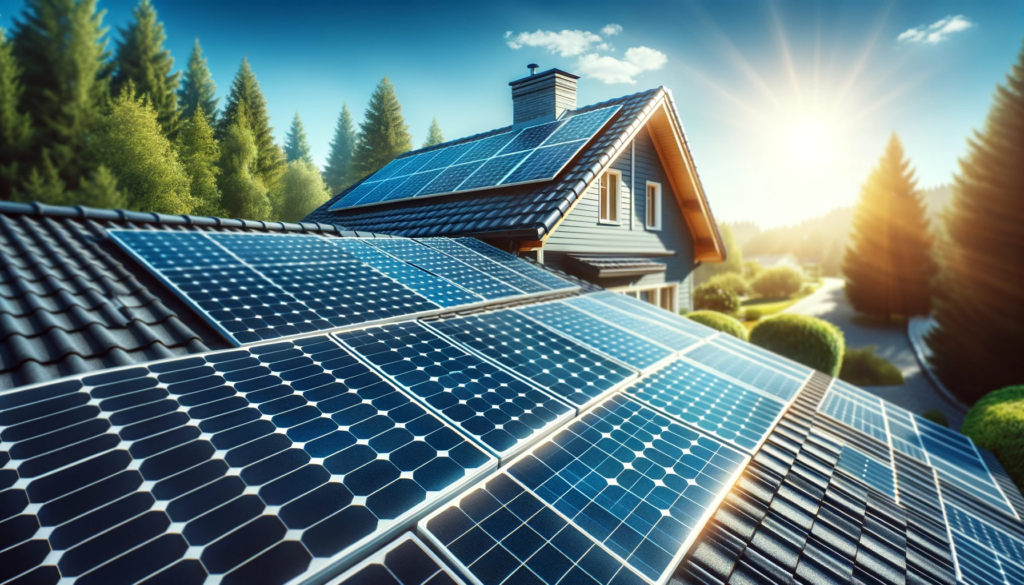
A Detailed Guide to Solar Panel Options and Their Financial Implications
Solar panel selection is a critical decision influencing both the cost and efficiency of solar energy systems. Let’s delve into an expert analysis of the three primary solar panel types, highlighting their cost and benefits, to assist homeowners in making an informed choice.
Solar Panel Types and Cost per Watt
| Solar Panel Type | Average Cost per Watt |
|---|---|
| Monocrystalline | $1 to $1.50 |
| Polycrystalline | $0.70 to $1 |
| Thin film | $1 to $1.50 |
- Monocrystalline Panels: Range from $1 to $1.50 per watt. These panels are a hallmark of efficiency and compact design. Composed of single silicon crystals, they offer superior energy generation per cell, making them a top-tier choice. Their durability is reflected in their impressive 40-year lifespan.
- Polycrystalline Panels: Priced between $0.70 and $1 per watt. These panels are known for their affordability. Constructed from fragmented silicon crystals, they offer a blue-hued alternative to monocrystalline panels. Though slightly less efficient, their cost-effectiveness and 25-30 year lifespan make them a sensible choice for budget-conscious homeowners.
- Thin Film Panels: Averaging $1 to $1.50 per watt. Distinguished by their flexibility and lightweight nature, these panels are ideal for various mounting surfaces. Their efficiency is lower, necessitating more panels for equivalent energy production, and their lifespan ranges from 10 to 20 years. In hotter climates, their performance remains stable, making them suitable for such environments.\
| Solar Panel Type | Average Cost per Watt |
|---|---|
| Monocrystalline | $1 to $1.50 |
| Polycrystalline | $0.70 to $1 |
| Thin film | $1 to $1.50 |
Advantages of Solar Panel Installation
Solar panels offer a range of benefits, not just in terms of cost savings but also environmental impact. Here’s an overview:
- Reduced Carbon Footprint: Installing solar panels is a step towards sustainable living, potentially reducing a home’s carbon emissions by up to 80% compared to traditional fossil fuels.
- Lower Utility Bills: Solar panels can significantly cut electricity costs, offering savings between $650 to $1,000 annually. Over 25 years, this could amount to substantial financial benefits.
- Tax Incentives: Homeowners can leverage federal and state tax breaks. The federal investment tax credit offers up to a 30% deduction on solar panel installation costs for certain periods. Additionally, various state-specific incentives and exemptions can further enhance the financial appeal of solar panels.
State-Wise Annual Savings
The financial benefits of solar panels vary by state, with potential annual savings as follows:
| State | Average Annual Savings |
|---|---|
| Arizona | $1,400 |
| California | $2,900 |
| Colorado | $1,600 |
| Florida | $1,500 |
| Maine | $2,300 |
| Massachusetts | $2,900 |
| New York | $2,300 |
| Texas | $1,500 |
| Washington | $1,100 |
Conclusion: The Value of Solar Panels
In summary, solar panels are a worthwhile investment, offering not only financial savings but also contributing to a greener, more sustainable world. For homeowners seeking to increase their property’s value and reduce electricity bills, exploring solar panel options is a prudent step.
Assessing the Return on Investment for Solar Panels
When considering What Is the Cost of Solar Panels?, an essential factor is the return on investment (ROI) associated with them. The ROI is influenced by the system’s size and local electricity costs. On average, homeowners reach the break-even point, also known as the payback period, in about 8.7 years. This duration can be shortened by leveraging local and federal incentives, along with tax breaks specifically designed for solar panel installations. Additionally, solar panels contribute to an increase in property value, a significant advantage as more eco-conscious buyers prefer homes with pre-installed solar panels.
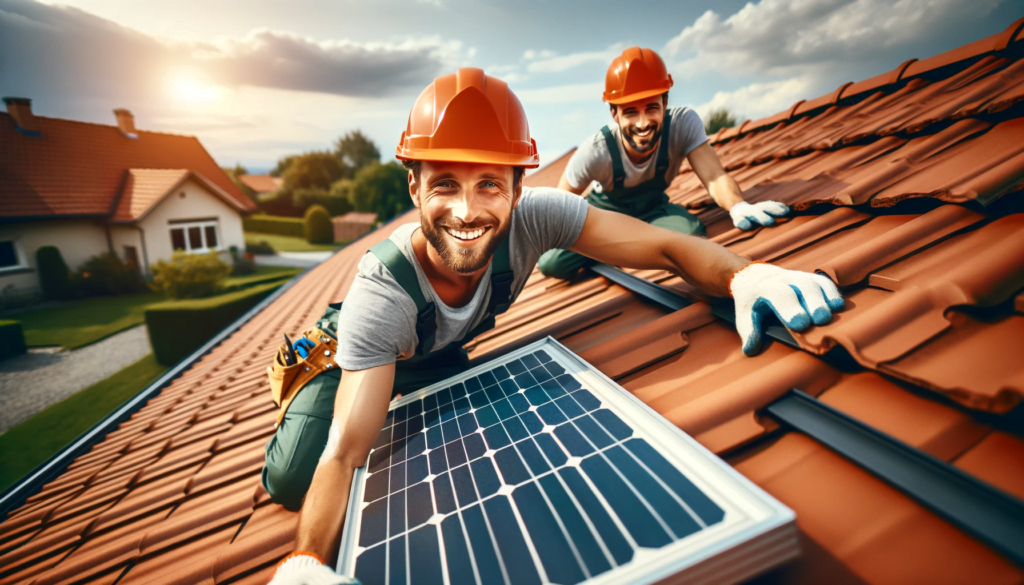
Solar Panel Installation: DIY versus Professional Expertise and Cost Considerations
When pondering the question, What Is the Cost of Solar Panels?, one must consider whether to undertake a DIY installation or hire a professional. Labor typically constitutes about 15% of the total solar panel installation cost. For example, in a 5kW system setup, labor costs might be around $2,250 out of a $15,000 total cost. This includes not just the panels, priced at about $5,100, but also the electrical system at $2,250. While DIY might seem a cost-saving option, the benefits of professional installation often outweigh the potential savings.
Benefits of Professional Installation
Professionals offer several advantages:
- Access to high-quality materials at manufacturer-direct prices, often more affordable than retail costs.
- Expert knowledge in solar panel design, understanding of the solar panel federal tax credit, state credits, and the intricacies of the permit-pulling process.
- Compliance with manufacturer requirements for installation to maintain valid warranties.
Generally, the complexities of solar panel installation justify the cost of professional services, ensuring both efficiency and adherence to standards. Learn More About The Best Solar Panel Cleaning Services of 2024.
Strategies to Reduce Solar Panel Costs
- Multiple Quotes: Shopping around different solar companies helps in finding competitive pricing that fits your budget.
- Incentives and Tax Breaks: Leveraging federal and state tax incentives, as well as utility company discounts, can significantly lower the overall expense.
- PACE Program: The Property Assessed Clean Energy model facilitates financing for improvements, including solar panels, with repayment through property assessment.
- Financing Options: Exploring various financing avenues, such as loans from solar companies or traditional lenders, provides flexibility. Lease options may also be available.
- Cost-Effective Materials: Opting for polycrystalline solar panels, which are generally less expensive than monocrystalline or thin-film options, can be a budget-friendly choice. Additionally, fixed mounting systems can be more economical compared to adjustable ones.
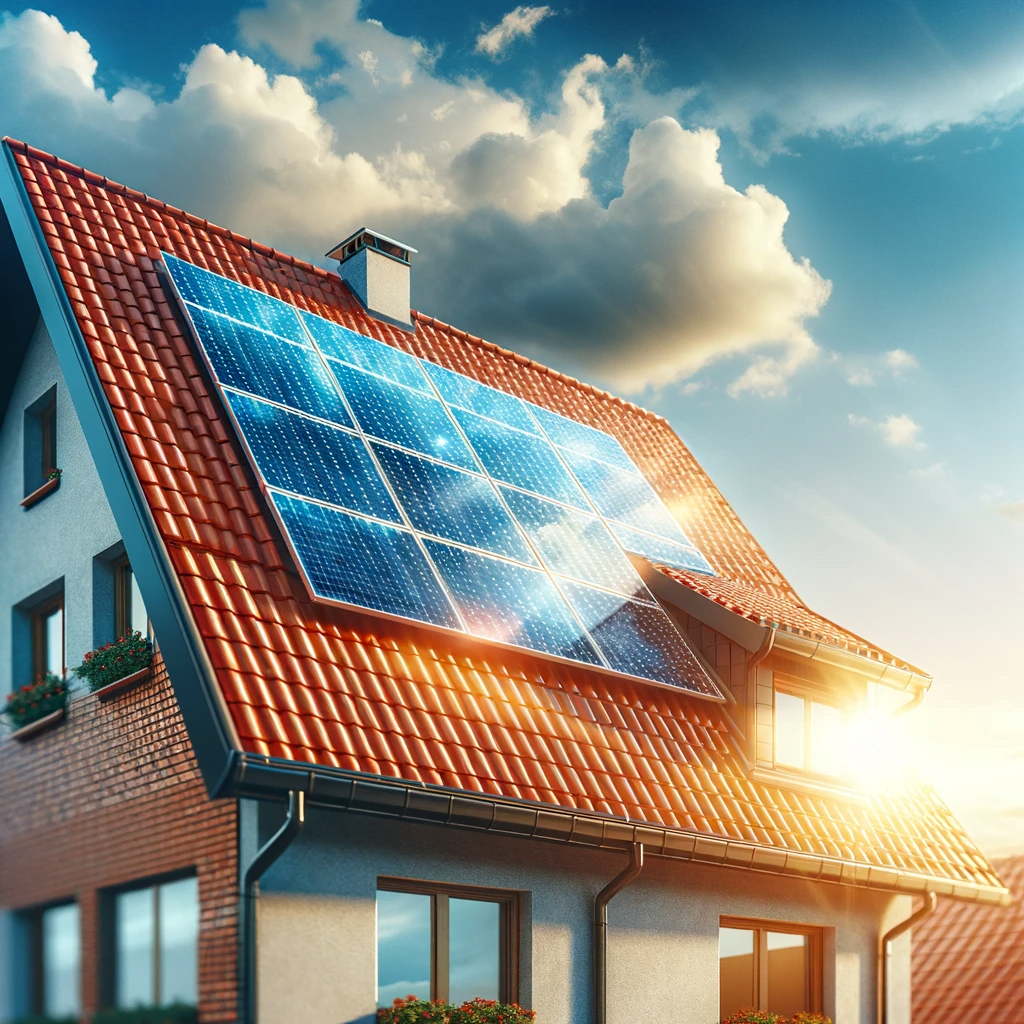
Key Questions for Solar Panel Installation: Maximizing Value and Minimizing Costs
When delving into the topic of What Is the Cost of Solar Panels?, it’s crucial to ask the right questions to your solar panel installation professional. This ensures clarity, cost-effectiveness, and that you receive a system tailored to your home’s needs. Consider these essential questions:
- What are your qualifications, licenses, and certifications?
- Can you share your experience with solar panel installations?
- Who will be responsible for the installation?
- What is the typical duration for completing the solar panel installation process?
- Could you provide references from previous clients?
- Will you handle all necessary permits and utility interconnection paperwork?
- What types and brands of solar panels do you typically use?
- Do you provide monitoring services for the installed solar panels?
- Are you equipped to install both on-grid and off-grid systems?
- What financing options are available through your company?
- Can you detail the warranties offered on equipment, installation, and power output?
- How do you calculate pricing for your services?
- What system size would best suit my home’s needs?
- Does my roof require modifications to support the solar panel system?
- Where would the solar panels be optimally placed?
- Is there flexibility to expand the system in the future?
- How can I benefit from tax breaks and incentives?
- What savings should I anticipate post-installation?
- What implications are there if I decide to sell my home?
FAQs on Solar Panel Costs and Installation
Understanding the financial aspect of solar panel installation can be complex. Here are some common FAQs to help guide homeowners:
Q: What is the typical cost to install solar panels?
A: Solar panel systems generally range from $18,100 to $35,064, averaging around $26,579. By utilizing federal and state tax credits and incentives, homeowners can reduce these costs. Overall, the long-term savings, increased property value, and ROI typically outweigh the initial investment.
Q: What are the payment options for solar panels?
A: Several payment methods are available:
- Full upfront payment: Paying the total amount upfront eliminates future payments, except for residual electric bills.
- Solar loans: Borrowing funds for the system and repaying them over time, often with interest.
- Solar lease or Power Purchase Agreement (PPA): You pay for the electricity generated by the solar panels, which remain owned by the solar company.
Q: How much can I save on energy bills with solar panels?
A: Average annual savings range between $650 to $1,500, potentially cutting monthly energy bills by up to 50%.
Q: What is the lifespan of solar panels?
A: Properly maintained solar panels can last between 25 to 35 years.
Q: Do solar panels function at night?
A: Solar panels require sunlight to generate power and do not produce energy at night.
Q: Can you explain net metering?
A: Net metering allows homeowners to sell excess power back to the grid, receiving credits for future energy use. This policy varies by state, so it’s important to check local regulations.
Q: Are solar panels covered by homeowners insurance?
A: Generally, yes, but coverage depends on the cause of damage. Policies typically cover events like hail damage but exclude negligence. Review your policy for specific coverage details.
Sources: HomeAdvisor, Angi, HomeGuide, Fixr

Leave a Reply